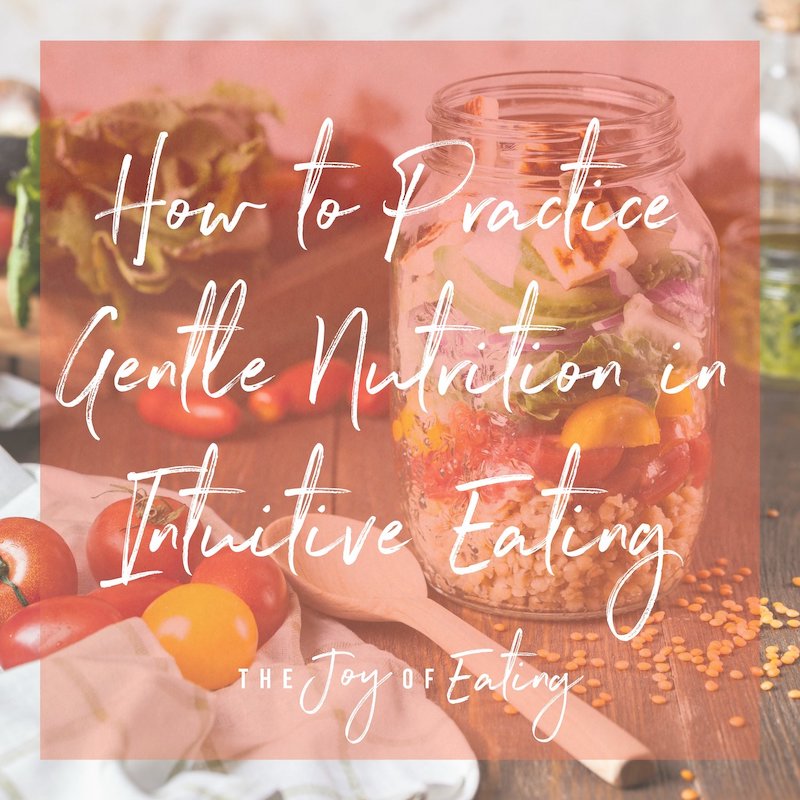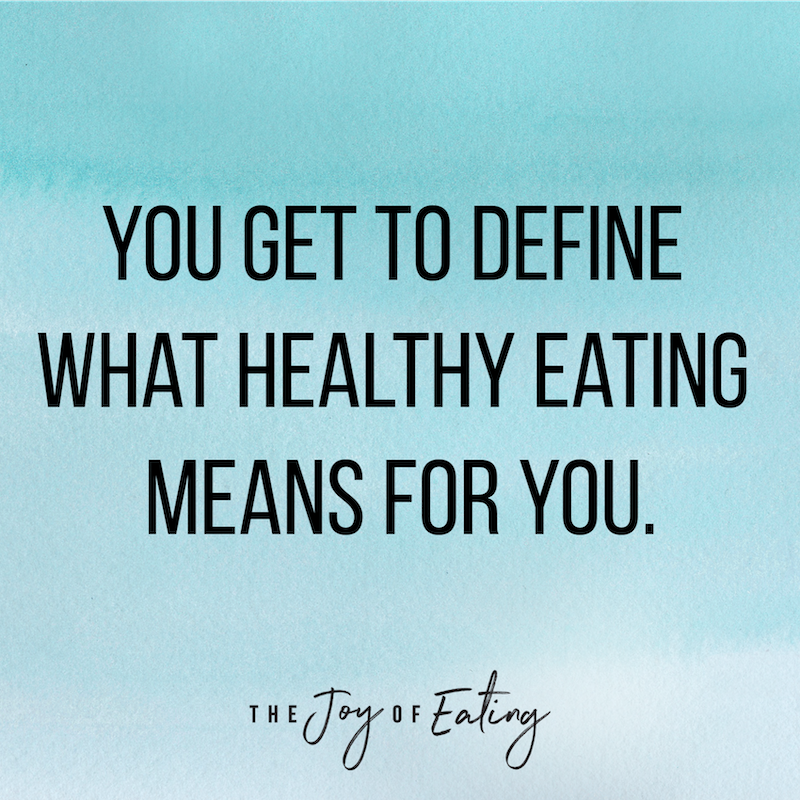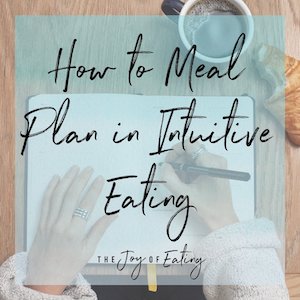How to Practice Gentle Nutrition in Intuitive Eating
There’s a good reason gentle nutrition is the last principle of intuitive eating. Without doing some work to heal your relationship with food, gentle nutrition can easily become yet another a diet. However saving it for last can make it feel like a bit of a mystery. This blog post helps demystify what gentle nutrition looks like so you are able to bring non-diet nutrition into your intuitive eating practice.
The 10th principle of Intuitive Eating is "honor your health with gentle nutrition." Expanding on the principle, the book reads:
“Make food choices that honor your well-being, taste buds, and culture; while attuning to how your body feels. Remember that you don’t have to eat perfectly to be healthy. You will not suddenly get a nutrient deficiency from one snack, one meal, or one day of eating. It’s what you eat consistently over time that matters. It might be surprising for you to learn that what you eat and how you move your body only accounts for ten percent of your health. Progress, not perfection, is what counts.” ~ Intuitive Eating, 4th Ed.
One of the biggest misconceptions about Intuitive Eating is that it's somehow anti-nutrition. That couldn't be further from the truth. It was developed by two registered dietitians after all! Personally, I believe (and there’s quite a bit of research backing this up) that moving away from rigid diet rules and weight management is a health promoting change on it’s own. However, integrating nutrition is also part of the intuitive eating paradigm - an entire principle of it’s own. Plus, by freeing up mental space and nurturing a healthy relationship with food, Intuitive Eating creates an environment that allows one to adopt health-promoting behaviors in a way that's actually sustainable.
That said, because it’s hard to talk about nutrition with any nuance to a large audience, especially when you know people will have different nutrition needs, goals, and will be at different stages in their process, gentle nutrition often gets ignored by us non-diet dietitians in our online communication. While it’s something that comes up frequently in our solo work with clients, it’s rarely discussed on social media. One of the reasons I wrote a book on gentle nutrition is because there is so much mystery about it, and I found that was actually inhibiting people’s ability to eat more intuitively. By not talking about gentle nutrition, it made it seem much more mysterious and complex than it actually is! A client once jokingly asked if gentle nutrition was an “award for passing the other 9 principles.” While it was mostly a joke, that’s when I knew I needed to talk more about gentle nutrition!
What is Gentle Nutrition in Intuitive Eating
Gentle nutrition defined…
Gentle nutrition is a flexible, non-diet, and evidence-based approach to healthy eating, one that centers on you and your unique individual needs. The goal of gentle nutrition is improving your health and wellbeing, not achieving a certain number on the scale. We live in a world where weight is often viewed as the be-all and end-all of health, and most “healthy” nutrition advice is built upon that misconception. But when nutrition advice aims to shrink bodies, there’s an inherent conflict with good nutrition—the kind of nutrition that can actually improve your health.
When asked to define gentle nutrition, I list a few characteristics:
Supports wellbeing vs. weight loss
Comes from a place of self care vs. self control
It’s flexible - any dietary change made to improve wellbeing must be flexible enough to allow you to live life in a way that feels good to you.
Individualized - gentle nutrition honors your unique nutrition needs, not to mention your lifestyle, preferences, and personal health goals or concerns.
It’s additive vs. subtractive - gentle nutrition adds nutrition in, while dieting takes food out
Focused on the big picture rather than each individual meal or snack
What does gentle nutrition in intuitive eating look like?
Gentle nutrition looks different for everyone, so it’s impossible to describe what gentle nutrition looks like! You get to decide what health looks like for you, and how you’d like to pursue it - not to mention if you would like to pursue health and whether nutrition will be a part of that. Health is a complex, nuanced thing - so much more than food and fitness - so sometimes taking care of your health and wellbeing involves deprioritizing nutrition or even not thinking about it at all.
Gentle nutrition can be as simple as throwing some veggies into a box of mac and cheese!
To demonstrate the individuality of what gentle nutrition, here’s examples of what it could look like for different people:
Someone who works multiple jobs or lacks food prep skills trying to add vegetables to frozen and boxed convenience meals.
Aiming to cook more meals at home using fresh, whole ingredients, and relying on takeout or frozen meals on days you don’t have time to cook.
Following a gluten free diet for celiac disease, and trying to find tasty gluten-free versions of the foods you loved before your diagnosis.
Putting some energy towards eating regularly throughout the day, getting fat, protein, carbs and fiber in your meals, and being mindful about sweets (but also including them!) to help manage diabetes (P.S. I have a whole blog post on non-diet nutrition for diabetes)
Following a meal plan/guidelines and regularly including challenge foods in eating disorder recovery. As I always remind people, eating enough food is by far the most important part of nutrition!
Avoiding whole grains and raw fruits and veggies because those are foods that trigger your IBS symptoms.
How to Practice Gentle Nutrition in Intuitive Eating:
As you can see, gentle nutrition looks different for everyone. The following are some tips for how to practice gentle nutrition in intuitive eating, but because of the individuality of gentle nutrition, some things may not apply to you or feel helpful. Feel free to take what you need and leave the rest!
Zoom out
Focus on the big picture instead of individual food choices. Individual food choices make very little difference when it comes to health, and yet we can put SO much time and headspace into obsessing over them. As I jokingly remind my clients when they’re feeling guilty about a meal, I don’t think you can look back to that fast food bacon cheeseburger and fries you had in 2005 and identify any permanent health effects, so whatever meal you’re stressing over today probably isn’t making a big difference in the context of your life either!
If you're thinking about ways to improve nutrition, it's worth thinking about big picture patterns, not obsessing over single meals or social eating situations. For example, if you pack your lunch most days, could you set a goal of throwing a piece of fruit in there? If you drink a lot of soda, is there a way you could incorporate more low sugar beverages, like water or flavored seltzer? If you eat toast every morning for breakfast, is there a whole grain bread that you enjoy and wouldn't mind switching to or alternating with? Those shifts in eating patterns are a lot more impactful than stressing over making the “healthiest” choice when you go out to dinner tonight, so save your headspace for what actually matters!
It’s helpful to have some go-to takeout meals that feel good to eat. One of my personal faves is this torched salmon bowl from a sushi spot that’s a 5 minute drive from us.
Focus on addition, not subtraction.
Most diet advice centers on restriction - strategies to eat less, not eat or limit certain foods, and "healthy" food swaps. With intuitive eating, all foods fit and all foods are morally equivalent. Of course, that doesn’t mean all foods are nutritionally equivalent. Some foods are more nutrient-dense than others. They have more vitamins, minerals, fiber, antioxidants, or other nutrients.
This is where a lot of people get confused with the message of intuitive eating, which is why I like to separate nutrition from healthfulness. For example, kale is more nutrient-dense than a coke, but just because it’s more nutrient-dense, that doesn’t mean it’s always the healthier choice. If your blood sugar is low or you are dehydrated and feeling dizzy or you about to do something very physically active, please drink the coke and do not chow down on leaves of kale - the latter will do absolutely nothing for you! All foods serve a purpose, and even foods that aren’t very nutritious may be the healthiest choice in certain situations, which is why I think it’s important not to demonize foods through restrictive diet advice.
Having some tasty side salad recipes in your repertoire makes it simple to whip up a veggie side to pair with your meals. This one is made with radishes, avocado (if i have it), picked red onion and a storebought yogurt dressing I love. Some other favorites are my chopped side salad and spring salad with sautéed peas.
Instead of restriction, gentle nutrition focuses on the addition of nutrient-dense foods. Here’s some examples:
Instead of cutting out or restricting red meat, picking a few recipes each week that include beans, fish, or tofu as a source of protein.
Rather than restricting chips, your favorite snack, find a few other snack foods you really love to keep on hand in the house, like whole grain cheese crackers tossed with almonds or peanut butter swirled into Greek yogurt.
Instead of cutting out refined grains, think about whole grains or other fiber-rich carbohydrate foods you love and how you can include them more often. Maybe you hate brown rice and whole grain pasta, but you love potatoes (both sweet and white potatoes are packed with fiber!), wild rice, triscuits and other whole grain crackers, and oatmeal? Eat those foods more frequently, and don’t worry about the ones you don’t like!
Think variety.
Eating a wide variety of food helps ensure you're getting adequate nutrition. Different foods contain different nutrients, so when we eat a wide variety of foods (not just a wide array of fruits and vegetables, but a wide array of proteins, fats, nuts and seeds, and carbohydrate sources) it protects against nutrient deficiencies and helps you get the vitamins, minerals and antioxidants your body needs.
Crackers and chips can easily be included in balanced and nutritious snacks. This example pairs crackers with omega-3 rich smoked salmon, a protein packed hard boiled egg (with dukkah seasoning) and crispy cucumbers. I also love to pair potato chips with yogurt dip and raw veggies.
Pay attention to what food feels good.
Paying attention to what food feels good to you, both physically and mentally, can help you figure out a way of eating that works for you. Nutrition is highly individual, so instead of offloading your body wisdom to some influencer or doctor or even dietitian who doesn’t live in your body, pay attention to what your body is telling you. For example, my husband feels best when he eats almost immediately after waking up, while I personally feel best when I wait about an hour. If I try to eat first thing, I feel awful. For my husband, if he has to wait an hour to eat, he feels awful. Neither is right or wrong, it’s just what works best for our individual selves.
Eat more fresh foods.
“Clean eating" has created a ton of fear around processed foods, and while I don’t advocate for clean eating and all of it’s fearmongering, there is a small kernel of truth in that there’s a benefit to eating more fresh, whole foods. Note, that doesn't processed foods are harmful or bad, just that there’s a nutrition benefit to including more nutrient-dense fresh foods. Eating more fresh foods doesn’t mean you have to cook everything at home from scratch. It can include simple things like adding fruit and peanut butter to instant oatmeal in the morning, whipping up a tasty side salad to pair with a frozen meal, or cooking a big batch of whole grains you can pair with or mix into meals throughout the week.
Salads that don’t suck are a great way to get in more fresh foods. This berry panzanella is a summertime favorite with tomatoes, strawberries, cherries, basil, mozzarella balls and crusty toasted croutons from ciabatta.
Another thing you can do is batch cook meals that you can enjoy leftovers of throughout the week, or freeze for later. Some of my favorites to meal prep from the blog are my veggie red curry, chicken burrito bowl, and whole grain apple cinnamon muffins.
Create an environment that makes it easier for you to make health promoting choices.
Feeding yourself multiple times a day is hard! Try to create an environment where it’s easier for you to make healthier food choices. Step number one to doing that is actually going to the grocery store so you have food in the house. Wild, I know, but you wouldn’t believe how many clients I work with rarely have enough food in the house, not because of finances but because they struggle to get in the habit of regular grocery shopping. As with everything, when it comes to meal planning different systems work for different people (here’s a blog post I wrote with some ideas), but generally speaking it’s helpful to have a day of the week that you go to the store, or at least order some staples for pickup.
Here’s some other ideas for creating an environment that makes health promoting choices easiser:
Pick up a tray of pre-cut fruit or veggies to have on hand for easy snacking.
There are lots of processed foods that are super nutritious and can make eating healthier easier. Some of my personal favorites are Amy’s canned chili (love it in a baked potato with cheese and guac for lunch!), microwave in a bag quinoa, salad kits (which I mix with cooked and cooled pasta and beans or chicken for a pasta salad), and instant oatmeal cups (which make “overnight” oats super simple). Here’s a blog post with more of my favorite processed foods.
Create a “master menu” of 5ish easy meals you can make when you’re in a rush. It’s great to have for those nights that you’d likely end up ordering takeout.
Have ingredients on hand to make a few different pantry meals with shelf stable or freezer ingredients. Some of my favorites are my pasta puttanesca, spinach and white bean pasta (which I made with frozen spinach), and migas.
Am I Ready for Gentle Nutrition?
Not everyone reading this may be ready to focus on gentle nutrition. If diet mentality is deeply engrained, or if you're active in an eating disorder/disordered eating, it's helpful to focus on recovery first. If you feel overwhelmed thinking about gentle nutrition, it’s OK to put nutrition on the backburner. You have the rest of your life to try to eat more veggies - there's no rush!
Most intuitive eating counselors point out that gentle nutrition is the last principle, and that it’s something you should hold off on integrating until you’ve done some work healing your relationship with food. I think that’s probably good advice for most people, but personally, I feel that gentle nutrition can be integrated throughout one’s intuitive eating journey. When we’re not treating intuitive eating principles as a step-by-step process, there’s a lot of latitude to integrate them in an individualized way that meets people where they are at and addresses their most pressing concerns. For some people, learning to take a more gentle approach to nutrition actually serves as a good intro to intuitive eating!
That said, I don’t think jumping right into gentle nutrition is particularly helpful. Before trying to more intentionally engage with nutrition, I think it’s important to check in with yourself to see what your goals of doing so are. This helps foster awareness of if and how much diet mentality is playing a role, and also by identifying your goals, it helps you tailor your nutrition goals to your needs. For example, if your gentle nutrition goal is to help manage IBS symptoms, that might look different than if your gentle nutrition goal is something else.
If you feel like you’re ready to engage in gentle nutrition, but are not sure how to start, feel free to reach out to us for intuitive eating coaching. As dietitians who value the power of nutrition, AND the importance of having a healthy relationship with food, I love to help clients discover how gentle nutrition can play a role in their life. Read more about our practice philosophy here to see if we’re a good fit for your needs. We see clients virtually throughout the US, and in our Columbia, SC office.












